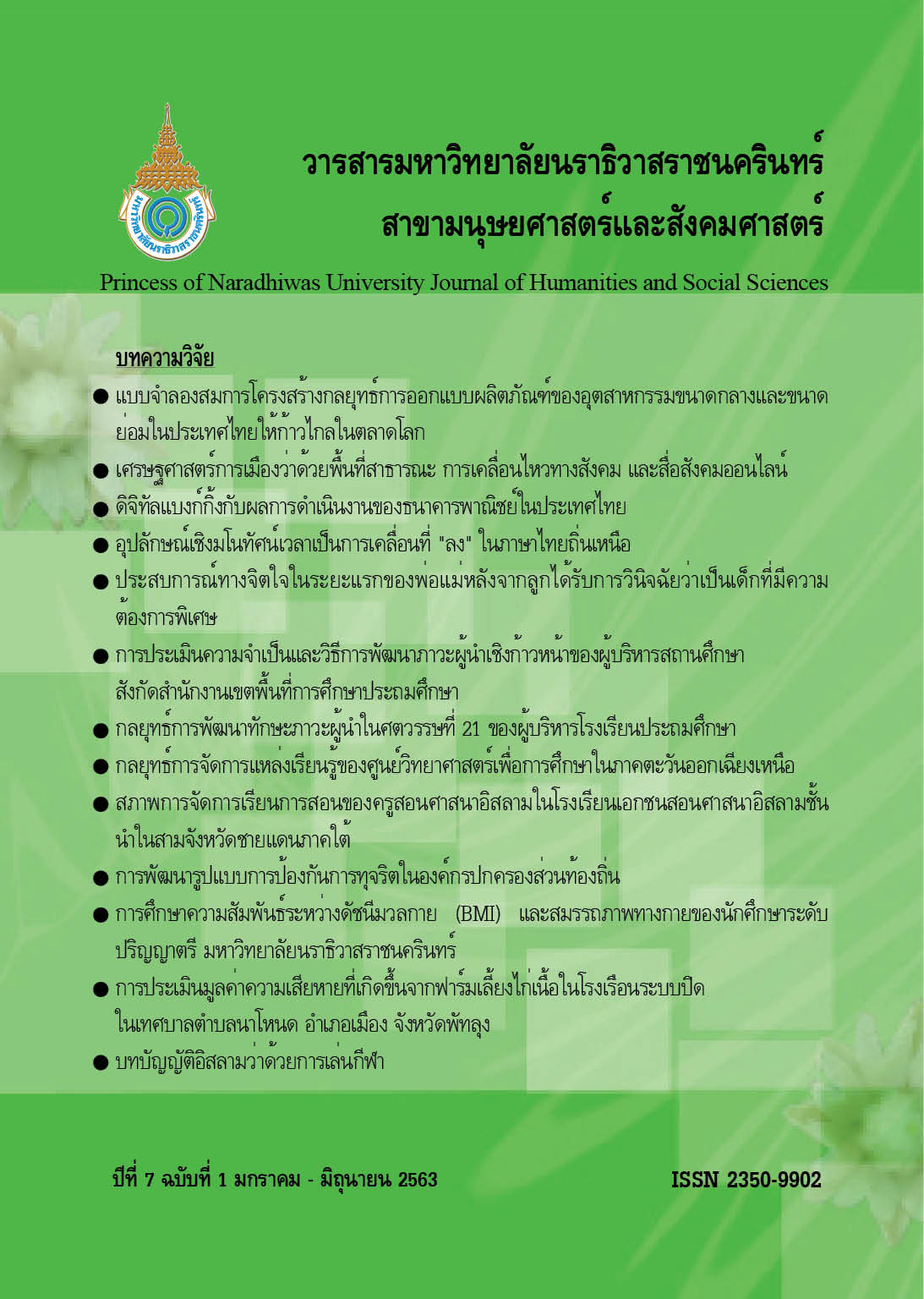Structural Equation Model of Strategic Product Design for Small and Medium Enterprise in Thailand Industry as Competitive Edge in World Market
Main Article Content
Abstract
This study was to design model of strategic product design for small and medium enterprise in Thailand industry as competitive edge in world market. The population consisted of entrepreneurs of small and medium enterprises (SME) in the business, 500 sample in qualitative research, and quantitative research
included 9 specialists to conduct in-depth interview selected by purposive sampling from 4 groups: business
sector, government sector, academic people, and designer. Data were analyzed using Structure Equation Model (SEM). The results of the Structure Equation Model (SEM) analysis showed that the evaluation criteria
were in consistent with empirical evidence: chi-square probability at 0.306, relative chi-square of 1.042, goodness of fit index of 0.957 and Root Mean Square Error (RMSE) of 0.009.
Article Details
References
ชาตรี ศรีไพพรรณ. (2553). แนวทางการพัฒนาเพื่อยกระดับธุรกิจ OEM สู่ ODM และ OBM แนวทางการพัฒนาเพื่อยกระดับธุรกิจ OEM สู่ ODM และ OBM. [วารสารออนไลน์] (สืบค้น 1 พฤศจิกายน 2561).จาก https://tmec.nectec.or.th/public/uploaded/Seminar/SubCon2010/Oem_odm_obm.pdf.
ธานินทร์ ศิลป์จารุ. (2560). การวิจัยและวิเคราะห์ข้อมูลทางสถิติด้วย SPSS. (พิมพ์ครั้งที่ 17), กรุงเทพฯ :วี อินเตอร์ พริ้นท์,
บัณฑิตพัฒนบริหารศาสตร์, สถาบัน. (2554). รายงานการศึกษาฉบับสมบูรณ์ (Final Report) โครงการจัดทำยุทธศาสตร์การพัฒนาศักยภาพเศรษฐกิจเชิงสร้างสรรค์ในอุตสาหกรรมแฟชั่น 2554. กรุงเทพฯ : สถาบันบัณฑิตพัฒนบริหารศาสตร์ศูนย์บริการวิชาการ.
ส่งเสริมวิสาหกิจขนาดกลางและขนาดย่อม, สำนักงาน. (2562). บทวิเคราะห์สถานการณ์ SME รายสาขา
ปี 2562. กรุงเทพฯ : สำนักงานส่งเสริมวิสาหกิจขนาดกลางและขนาดย่อม.
, สำนักงาน. (2562). รายงานสถานการณ์ วิสาหกิจขนาดกลางและขนาดย่อม ปี 2561. กรุงเทพฯ : สำนักงานส่งเสริมวิสาหกิจขนาดกลางและขนาดย่อม.
สมาคมวิชาชีพที่ปรึกษาธุรกิจ. (2556). การรับผลิตสินค้าให้กับบริษัท. [วารสารออนไลน์] (สืบค้น 11 พฤศจิกายน 2561), จาก https://www.smeservicecenter.net/public/uploads/p13799217716129123704.pdf
Aghajari, N. & Senin, A/A. (2014). Strategic Orientation and Dual Innovative Operation Strategies. Asia-Pacific Journal of Business Administration, 6(2), 127-147
Arbuckle, J. L. (2011). IBM® SPSS® AmosTM 20 User’ Guide. Mount Pleasant : Amos Development Corporation.
Bamey, J./B. (2012) Purchasing, Supply Chain Management and Sustained Competitive Advantage : The Relevance of Resource-Based Theory. Journal of Supply Chain Management, 48(2), 3-6
Comrey, A. & Lee, H. (2002). A first Course in Factor Analysis. Hillsdale, N J: Erlbaum.
Cui, S.A., & Wu, F.(2016). Utilizing Customer Knowledge in Innovation: Antecedents and Impact of Customer Involvement on New Product Performance. Journal of the Acad. Mark. Sci. Accepted : 10 February 2015 Public Online.
Fornoni, M., et al. (2012). “An Entrepreneur's Social Capital and Performance: The Role of Access to Information in The Argentinean Case.” Journal of Organizational Change Management, 25(5), 682–698
Gilbert R., Loxley, D., Tomley, S., & Walisiewicz, M. (2014). The Business Book. London. Dorling Kindersley Limited.
Kamboj, S. & Rahman, Z. (2017). Market Orientation, Marketing Capabilities and Sustainable Innovation: The Mediating Role of Sustainable Consumption and Competitive Advantage : Management Research Review, 40(6), 698-724, Retrieved from https://doi.org/10.1108/MRR-09-2014-0225
Kotler, P. & Armstrong, G. (2013). Principles of Marketing. (15th ed). Englewood : Prentice Hall.
Naiman, L (2018). Design Thinking as a Strategy for Innovation.
Retrieved January 31, 2018, from https://www.creativityatwork.com/design-thinking-strategy-for-innovation.
Panda, S. & Rath, K. S. (2018). Strategic IT-Business Alignment and Organizational Agility: from a Developing Country Perspective, Journal of Asia Business Studies.
Retrieved from https://doi.org/10.1108/JABS-10-2016-0132.
Rahman, S. M. & Mannan, M. (2018). Consumer Online Purchase Behavior of Local Fashion Clothing Brands: Information Adoption, e-WOM, Online Brand Familiarity and Online Brand Experience, Journal of Fashion Marketing and Management: An International Journal, 22(3), 404-419,
Ruiz-Jimenez, M./J. & Fuentes-Fuentes, M./M. (2013). Knowledge Combination, Innovation, Organizational Performance in Technology Firms, Industrial Management & Data Systems, 113(4), 523–540
Valaei, N., Rezaei, S. & Emami, M. (2017). Explorative Learning Strategy and Its Impact on Creativity and Innovation: An Empirical Investigation Among ICT-SMEs, Business Process Management Journal, 23(5), 957-983


